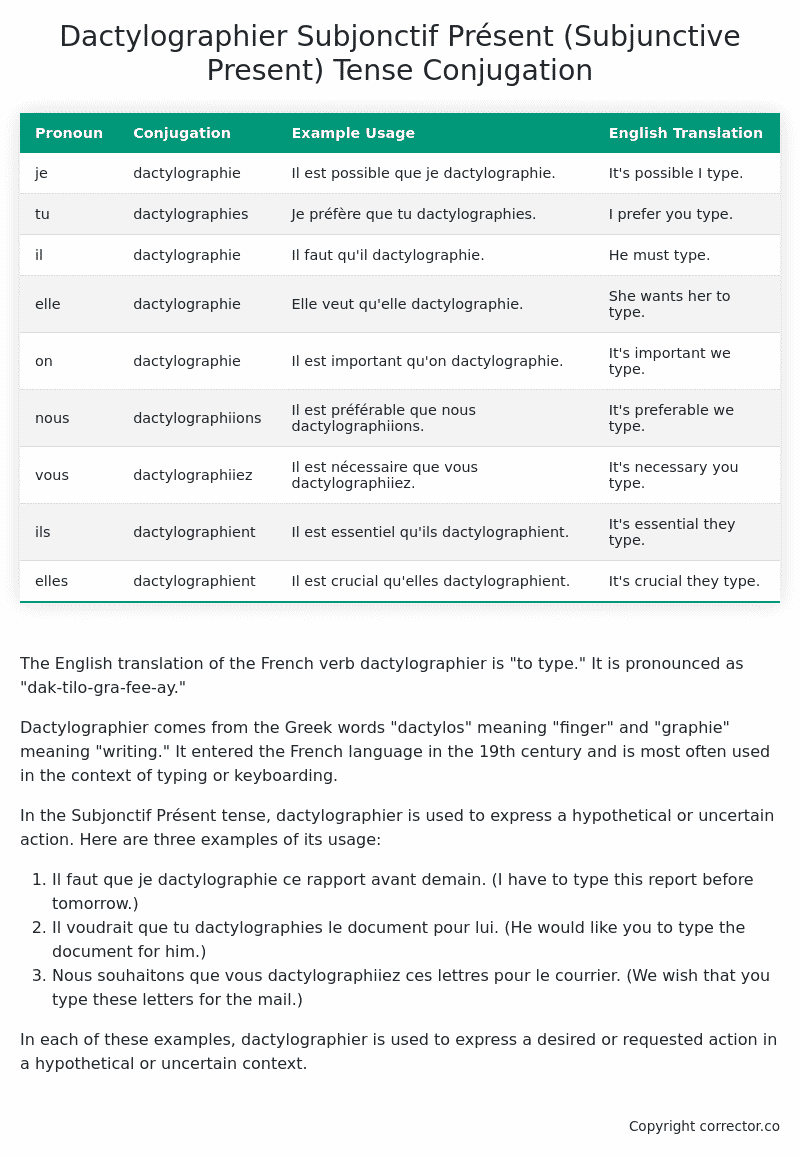Subjonctif Présent (Subjunctive Present) Tense Conjugation of the French Verb dactylographier
Introduction to the verb dactylographier
The English translation of the French verb dactylographier is “to type.” It is pronounced as “dak-tilo-gra-fee-ay.”
Dactylographier comes from the Greek words “dactylos” meaning “finger” and “graphie” meaning “writing.” It entered the French language in the 19th century and is most often used in the context of typing or keyboarding.
In the Subjonctif Présent tense, dactylographier is used to express a hypothetical or uncertain action. Here are three examples of its usage:
- Il faut que je dactylographie ce rapport avant demain. (I have to type this report before tomorrow.)
- Il voudrait que tu dactylographies le document pour lui. (He would like you to type the document for him.)
- Nous souhaitons que vous dactylographiiez ces lettres pour le courrier. (We wish that you type these letters for the mail.)
In each of these examples, dactylographier is used to express a desired or requested action in a hypothetical or uncertain context.
Table of the Subjonctif Présent (Subjunctive Present) Tense Conjugation of dactylographier
| Pronoun | Conjugation | Example Usage | English Translation |
|---|---|---|---|
| je | dactylographie | Il est possible que je dactylographie. | It’s possible I type. |
| tu | dactylographies | Je préfère que tu dactylographies. | I prefer you type. |
| il | dactylographie | Il faut qu’il dactylographie. | He must type. |
| elle | dactylographie | Elle veut qu’elle dactylographie. | She wants her to type. |
| on | dactylographie | Il est important qu’on dactylographie. | It’s important we type. |
| nous | dactylographiions | Il est préférable que nous dactylographiions. | It’s preferable we type. |
| vous | dactylographiiez | Il est nécessaire que vous dactylographiiez. | It’s necessary you type. |
| ils | dactylographient | Il est essentiel qu’ils dactylographient. | It’s essential they type. |
| elles | dactylographient | Il est crucial qu’elles dactylographient. | It’s crucial they type. |
Other Conjugations for Dactylographier.
Le Present (Present Tense) Conjugation of the French Verb dactylographier
Imparfait (Imperfect) Tense Conjugation of the French Verb dactylographier
Passé Simple (Simple Past) Tense Conjugation of the French Verb dactylographier
Passé Composé (Present Perfect) Tense Conjugation of the French Verb dactylographier
Futur Simple (Simple Future) Tense Conjugation of the French Verb dactylographier
Futur Proche (Near Future) Tense Conjugation of the French Verb dactylographier
Plus-que-parfait (Pluperfect) Tense Conjugation of the French Verb dactylographier
Passé Antérieur (Past Anterior) Tense Conjugation of the French Verb dactylographier
Futur Antérieur (Future Anterior) Tense Conjugation of the French Verb dactylographier
Subjonctif Présent (Subjunctive Present) Tense Conjugation of the French Verb dactylographier (this article)
Subjonctif Passé (Subjunctive Past) Tense Conjugation of the French Verb dactylographier
Subjonctif Imparfait (Subjunctive Imperfect) Tense Conjugation of the French Verb dactylographier
Conditionnel Présent (Conditional Present) Tense Conjugation of the French Verb dactylographier
Conditionnel Passé (Conditional Past) Tense Conjugation of the French Verb dactylographier
L’impératif Présent (Imperative Present) Tense Conjugation of the French Verb dactylographier
L’infinitif Présent (Infinitive Present) Tense Conjugation of the French Verb dactylographier
Struggling with French verbs or the language in general? Why not use our free French Grammar Checker – no registration required!
Get a FREE Download Study Sheet of this Conjugation 🔥
Simply right click the image below, click “save image” and get your free reference for the dactylographier Subjonctif Présent tense conjugation!

Dactylographier – About the French Subjonctif Présent (Subjunctive Present) Tense
Formation of the Subjonctif Présent
Common Everyday Usage Patterns
Interactions with Other Tenses
Summary
I hope you enjoyed this article on the verb dactylographier. Still in a learning mood? Check out another TOTALLY random French verb conjugation!


